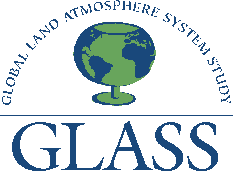|
The Rhone-AGGregation (Rhone-AGG) Soil-Vegetation-Atmosphere-Transfer
(SVAT) model
intercomparison project is an initiative within the
GEWEX/GLASS
(Global Land-Atmosphere System Study
: Polcher et al. 2000)/GSWP
(Global Soil Wetness Project
: Dirmeyer et al. 1999)
panel of the WCRP. This project makes use of the
Rhone modeling system, which was developed in recent
years by the
French research community1.
Three distinct components comprise this
system: a distributed hydrological model, an
analysis system to determine the near-surface atmospheric
forcing and a SVAT model
interface. The coupling between the three components of the system is 1-way.
It was created in an attempt to ensure
a consistent dialogue between the atmospheric (precipitation,
radiative fluxes, state variables) and the
hydrological variables (evaporation, soil moisture, runoff,
ground water and river flow) on a regional scale.
The system utilizes high spatial
resolution European soil and vegetation databases, but it
has been designed such that it is transferable
to other regions.
The entire Rhone model domain size is
on the order of that of a coarse-resolution Global
atmospheric Climate Model (GCM), but the
atmospheric forcing, the soil and vegetation parameters, and the
observed river discharges are available at a significantly
higher spatial resolution.
It is then of interest to examine how the simulations
from a wide range of SVAT schemes, which are used in
GCMs, Numerical Weather Prediction (NWP) models, mesoscale
atmospheric models or hydrological models,
are impacted by changing the spatial resolution over the domain.
The main goals of the Rhone-AGG
are then to examine how various state of the art SVAT schemes are able
to simulate the river discharge over several annual cycles
when inserted into the Rhone modeling system, and
to explore the impact of the various scaling or aggregation methods
on the simulation of certain components of the hydrological cycle
(such as snow cover and surface runoff).
A limited number of multi-year (four total)
experiments have been developed in an attempt
to adequately address the posed science questions. The simulation
time period (August, 1985, through July, 1989)
was also selected in order to coincide with the
GSWP experiments (1987-1988).

Global Soil
Wetness Project
|

|
1 The authors would like to thank all their colleagues at
the many French laboratories which have participated in the development
of the Rhone modeling system.
This work was supported by the program National d'Etude du Climat
(PNEC), and by the
Program National de Recherches en Hydrologie (PNRH).
The Institut Francais d'ENvironnement
(IFEN), Institut National Recherche Agronomique (INRA),
the Banque Hydrologie, the French Environment Ministry and
Météo-France
provided the land-cover, soil, river flow
and atmospheric data bases.
The GEWEX-Rhone group consists of Météo-France
(GMME: Group de Météorologie de Moyenne Echelle and CEN: Centre d'Etudes de la Neige),
Centre Informatique et G\'eographique (CIG), Centre d'Etude du Machinisme Agricole,
du Génie Rural, des Eaux et Forets (CEMAGREF),
Centre d'etude des Environnements Terrestre et Planétaire (CETP),
Laboratoire d'etude des Transferts en Hydrologie et Environnement (LTHE) and
Bureau de Recherches Géologiques et Minieres (BRGM).
|

